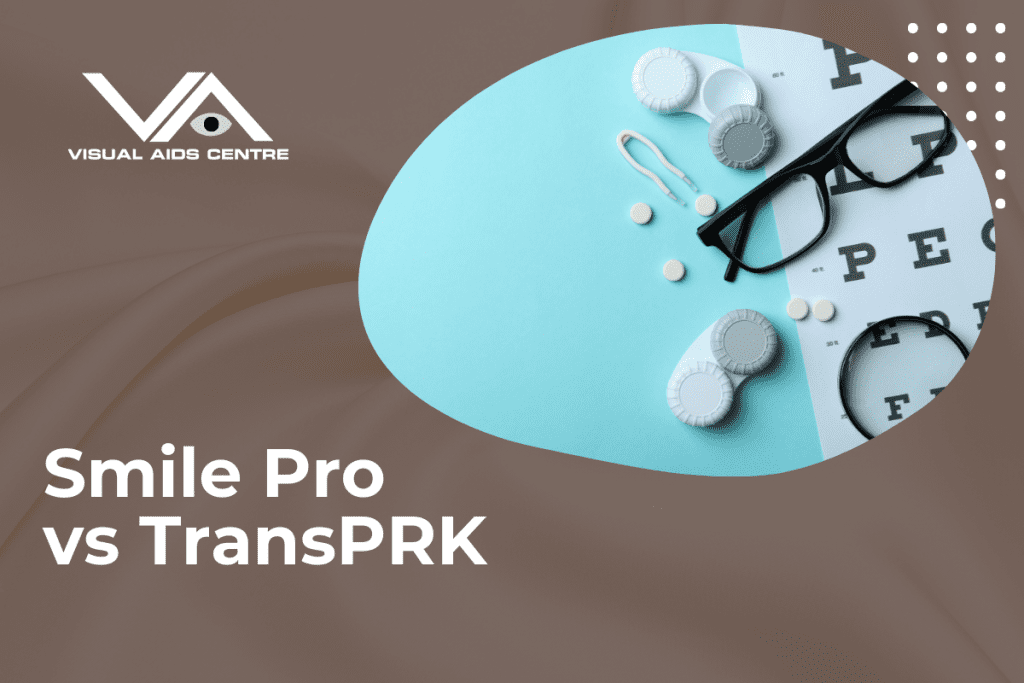Table of Contents
ToggleIn the realm of laser eye surgeries, two cutting-edge procedures, TransPRK (Transepithelial Photorefractive Keratectomy) and Smile Pro (Small Incision Lenticule Extraction), have emerged as minimally invasive solutions to correct vision problems. Both techniques utilize advanced technology to reshape the cornea and address refractive issues.
In this comprehensive guide, we delve into the nuances of these procedures, comparing their key aspects to help you make an informed decision about your vision correction journey.

Understanding the Basics
Smile Pro
Smile Pro, introduced by ZEISS, utilizes the VisuMax 800 femtosecond laser technology. Smile Pro involves the creation of a tiny lens-shaped piece of tissue (called a lenticule) inside the cornea through a 2 mm micro-incision and then removing the lenticule, omitting the need for corneal flaps and then reshaping the cornea.
This flapless procedure offers a fast and comfortable healing process with a surgery duration of just 7-9 seconds per eye.
TransPRK
TransPRK (no touch, no cuts PRK) stands out as an Advanced Surface Ablation (ASA) procedure, eliminating the need for corneal flaps.
This surface-based technique employs the Schwind Amaris excimer laser to reshape the cornea by vaporizing and then removing the regenerable epithelial layer (the outermost layer of the cornea) on the surface of the eye and precisely sculpting the underlying corneal stroma. After the procedure, a contact lens is gently applied to the eye, serving as a protective bandage for a period of four to five days. This aids in the healing process and ensures optimal recovery.
The absence of physical contact with the eye during the procedure contributes to a quick and comfortable healing process with a surgery duration of 3-5 minutes per eye.
Comparative Analysis
1. Degree Correction Criteria
TransPRK
Myopia/ shortsightedness up to -10 diopters,
Astigmatism up to -5 diopters,
Hyperopia/ longsightedness up to -4 diopters and
Presbyopia
Smile Pro
Myopia/ shortsightedness up to -10 diopters and
Astigmatism up to -5 diopters
2. Suitability Criteria
Corneal thickness plays a pivotal role in determining the eligibility for each procedure.
TransPRK is suitable for thinner or unusual corneas with at least 485 microns thick, while Smile Pro requires a minimum corneal thickness of 550 microns. Smile Pro has a narrower range of suitability criteria, excluding hyperopia, high myopia or thin cornea.
3. Incision
During the Smile Pro procedure, a small incision of 2-4 mm is made, whereas TransPRK is a contactless technique that requires no incision at all.
4. Surgical Techniques
TransPRK, an Advanced Surface Ablation (ASA) procedure, distinguishes itself by eliminating the need for creating a corneal flap or manual removal of epithelium, steps present in traditional PRK and Epi-LASIK. The procedure is performed exclusively using the Schwind Amaris excimer laser, which ensures a faster, more precise, and uniform healing process for patients. Additionally, this advanced technology enhances patient comfort throughout the recovery period.
Conversely, Smile Pro, introduced by ZEISS, utilizes the femtosecond laser technology of the ZEISS VisuMax 800 laser. This technique involves extracting a lenticule without the need for creating a corneal flap. It offers a precise, speedy (with a pulse frequency of 500 kHz), stable, and gentle treatment approach.
5. Pain and Discomfort
Patients opting for Smile Pro experience minimal to no pain during and after the procedure, offering a more comfortable post-operative period compared to TransPRK, which is associated with a higher level of discomfort, including pain lasting 1 to 2 days and more post-op inflammation.
Recovery Time and Follow-up
TransPRK requires a lengthier healing period. It may take up to a week for the surface cells to completely heal, accompanied by initial discomfort such as mild itchiness or soreness on the eye’s surface. Within 2-3 months, visual clarity stabilizes and reaches its full potential.
Smile Pro showcases a faster initial recovery, with patients experiencing same-day visual improvement and achieving full visual clarity within a few weeks.
Patients can return to light sports activities sooner with Smile Pro compared to TransPRK. Moreover, Smile Pro entails fewer follow-ups and medications when compared to TransPRK.
Cost Comparison
The financial aspect is crucial in decision-making. TransPRK is priced at INR 75,000 for both eyes, while Smile Pro comes at a higher cost of INR 1,50,000 for both eyes.
Infection
TransPRK, similar to other surface treatments, carries a higher risk of infection when compared to Smile Pro.
Dry eyes may persist for a longer duration following TransPRK when compared to Smile Pro.
However, Smile Pro does come with a 1% risk of complications related to lenticule.
Corneal cross-linking (CXL)
For TransPRK, it is recommended to consider CXL as an additional treatment if you have a thin cornea, high astigmatism, and/or high myopia. However, in the case of Smile Pro, CXL is not recommended as an additional treatment.
Navigating Your Choice
As you stand at the crossroads of deciding between Smile Pro and TransPRK, the journey to visual clarity is marked by careful consideration of diverse individual factors. Delving into the intricacies of your unique circumstances is crucial to ensuring the optimal choice for your vision correction needs. The considerations include the severity of vision problems, pain tolerance, desired recovery time, and budget constraints.
Both procedures offer innovative solutions for vision correction, but the nuances in their approaches can greatly impact the overall patient experience.
By engaging in a thoughtful consultation with an eye care professional, you pave the way for an informed decision that not only corrects your vision but also aligns seamlessly with your individual needs and aspirations.









